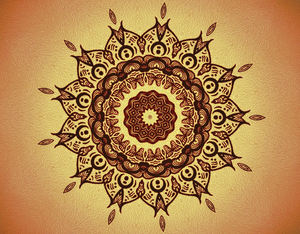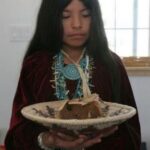Sand painting is a staple of Southwestern culture and crafts. Traditionally, in Navajo culture, sand painting is a living creation performed by a medicine man and has a healing, spiritual connection. The sacred, symbolic images of Southwestern sand paintings are symmetrical, representative of the balance and harmony a sick person needs to achieve. Once the design was completed, the patient and medicine man would sit upon the paintings while chanting. This process creates a portal for the flow of spirit. Upon the ceremony’s completion, the sand painting is destroyed, as it is believed to be contaminated since it absorbed the patient’s sickness.
Modern sand paintings have become pieces of artwork, some holding great value. You can easily create your own sand painting in an evening. With practice, you can perfect this Southwestern craft into elaborate paintings to match any décor.
Materials:
Colored sand (ok to make own or use salt)
White glue
Paintbrush
Thick paper (file folder)
Pencil
Site Preparation:
Lay newspaper or plastic to cover your workspace. Select work surface – if using paper, use a heavy gage paper – cutting a square out of a file folder provides a nice heavy gauged paper. (Using a colored paper permits easy recognition of any missed glued areas). Experiment with different surfaces such as cardboard (cut up your child’s cereal box), wood, poster board or foam.
Sand Preparation:
Colored sand may be purchased or consider creating your own by placing sand or salt in a zip lock bag, then thoroughly mix in a few drops of food coloring. Another alternative is using dry tempera paint by mixing 1-teaspoon water, 2 teaspoons dry tempera paint to one cup sand. Be sure to let the colored sand dry for several hours before use. For material that is white or pastel colored use salt instead of sand and cut in sidewalk chalks.
Design:
Using a pencil, draw desired design on selected work surface. First projects are most successful by using geometric shapes – simple designs with large areas for color. Through an internet search, you can easily find traditional images. Assign a color for each area and lightly write in a letter for the color. Example: “B” for blue.
An alternative to sketching is to use the pictures from a coloring book. Either glue the page onto your chosen work surface or copy onto surface by tracing design over transfer paper.
Glue Preparation and use: Pour glue into a small cup – add a a few drops or water and thoroughly stir. The desired consistency will be similar to paint.
Using a flat paintbrush, apply the glue to areas of your sketch that are going to be the same color. Use brush strokes as if you were painting with glue. Working in small segments, cover the selected area completely. Do not cover all the areas with glue at one time. If you have decided to use blue first, paint glue onto one or two of the areas you want to be blue. (It is not necessary to glue-paint all areas of a chosen color at one time).
Sand Pouring: Fold a sheet of bond paper in half. Pour selected colored sand into the crease of the folded paper by holding the folded paper over your work surface, pour out small amounts of sand over the fresh glue by tipping/tapping the paper. Repeat this process until you have completely covered the glue-painted area. Carefully pour extra sand back into the original jar or container. After completing all the areas of one color, move to the next color. When all areas are covered, set aside to dry.
Outlines add a nice finishing touch which cover a multitude of imperfections. To form outlines, use glue directly out of the bottle, running a thin bead along your desired outline area. Sprinkle the selected sand color. If an area bulges or bubbles out of the desired line you can redistribute the glue by using a toothpick or stub end of the paintbrush.
An effective non-messy alternative way to create a sand painting is to transfer a design onto a piece of fine or medium grit sand paper. Then color picture using colored pencils.
Sources:
Personal Experience





